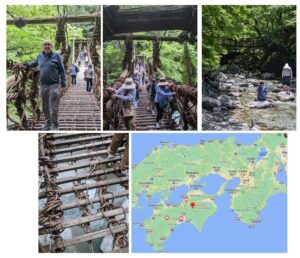Whether the action movie is Indiana Jones, Jumanji or Lord of the Rings, there’s always a precarious rope bridge for the heroes to cross, isn’t there? Needless to say, the movie bad guys will inevitably cut the ropes, forcing our heroes to hang onto the bridge for dear life. Fun stuff! But would you want to actually cross a rickety rope bridge yourself? Or worse, what if the bridge was made of vines instead of rope?
If you go to the Iya Valley, in the center of Shikoku, Japan, you’ll find not one, not two, but three traditional vine bridges. And yes, you can cross them. I approach my own vine bridge crossing pretty with an air of nonchalance. I mean, “How scary could it be? It’s only, like, 50 feet over the river.” Imagine my surprise when I discover that 1) the bridge is quite crowded with clumsy, jostling tourists, 2) there are big gaps between the bridge slats! In other words, I can most definitely see the river rushing wildly beneath my feet! If one of the other tourists accidentally throws an elbow, I’m going straight into the brink! For a guy like me with a slight case of acrophobia (fear of heights), crossing a vine bridge is a bit more of a hair-raising experience than I’d ever imagined. It’s also way cooler!

The source of Iya Valley’s vine bridges is somewhat murky. Some say Kōbō-Daishi, the founder of Shingon Buddhism, created them –as if he wasn’t busy enough, what with founding 88 pilgrimage temples around the island. The other, more likely, explanation is that refugees from the Heike clan built the bridges to help escape the pursuing Genji clan. After all, it’s easier to elude your enemies if you cut down the bridge behind you. Whoever created the bridges was certainly pretty clever, growing Wisteria vines to sufficient length and then weaving them together before attaching them to planks.
As I mentioned, there are only 3 vine bridge left in the valley – stabilized, thankfully, with steel cables. The first one (to the west) gets a lot of big-tour traffic. The other two are a one-hour trip further east along a tiny, one-lane road with no turnouts. I’m definitely thankful for the small, round mirrors at dangerous turns. If you go, I’d advise you make the longer trip east to see the smaller bridges. They’re less crowded and you can go down to the river, which is gorgeous.
(What’s your vine bridge? Remember that you don’t have to cross the whole river on your first go. Just start with one rickety plank at a time. And watch out for stray elbows.)
